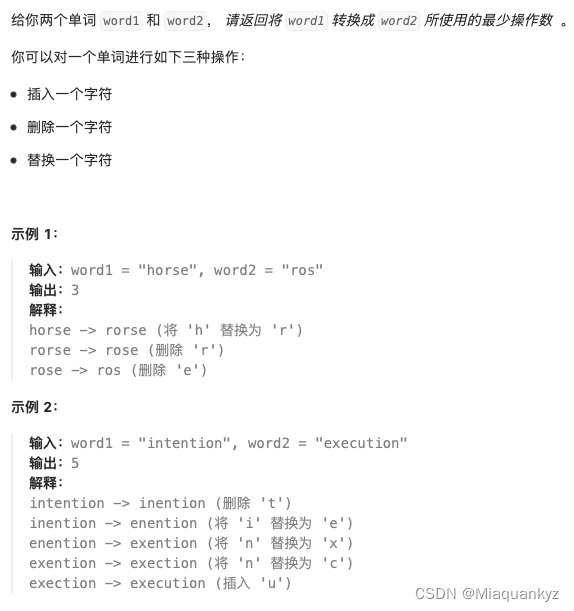编辑距离的基本思想很直观,即不断比较两个单词每个位置的元素,若相同则比较下一个,若不同则需要考虑从插入、删除、替换三种方法中选择一个最优的策略。涉及最优策略笔者最先想到的即是动态规划的思想,将两个单词的位置对应放在矩阵中即可将其转化为类似求解最小路径和的问题。
示例:

图1 编辑距离输入输出示意图
代码:
class Solution:def minDistance(self, word1: str, word2: str) -> int:cost = [[float("inf")] * (len(word2) + 1) for _ in range(len(word1) + 1)]for i in range(len(word1) + 1):cost[i][len(word2)] = len(word1) - ifor j in range(len(word2) + 1):cost[len(word1)][j] = len(word2) - jfor i in range(len(word1) - 1, -1, -1):for j in range(len(word2) -1, -1, -1):if word1[i] == word2[j]:cost[i][j] = cost[i + 1][j + 1]else:cost[i][j] = 1 + min(cost[i + 1][j], cost[i][j + 1], cost[i + 1][j + 1])return cost[0][0]解释:
1)cost为记录最少操作数的二维数组,若word2为空,word1变为word2需要删除word1中所有字符,即操作数为len(word1)。同理,若word1为空,word1变为word2需要插入word2中所有字符,即操作数为len(word2):
for i in range(len(word1) + 1):
cost[i][len(word2)] = len(word1) - i
for j in range(len(word2) + 1):
cost[len(word1)][j] = len(word2) - j
2)对于cost其他位置的最少操作数,则根据动态规划的思想,若两个位置对应的字符相同,则指针均向后移位,反之,则需要从插入、删除、替换三种操作中选择一种,选择三种操作后所需最少操作数的方法:
for i in range(len(word1) - 1, -1, -1):
for j in range(len(word2) - 1, -1, -1):
if word1[i] == word2[j]:
cost[i][j] = cost[i + 1][j + 1]
else:
cost[i][j] = 1 + min(cost[i + 1][j], cost[i][j + 1], cost[i + 1][j + 1])
3)算法图解

图2 编辑距离算法图解
另附上最小路径和解决方法:
LeetCode 64 in Python. Minimum Path Sum (最小路径和)-CSDN博客
)
项目封装弹窗组件)

详解)









)





